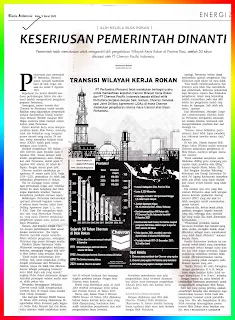PT Pertamina EP recorded value creation consisting of efficiency (cost-saving) and additional revenue from the creativity and innovation of company workers over the past three years totaling the US $ 566 million or equivalent to Rp 7.8 trillion (average exchange rate of Rp13,925 per US dollar on last three years) of the target of US $ 87.5 million.
Of the 1,602 innovations produced by Pertamina EP (PEP) workers in the 2017-2019 period, 98 innovations have been replicated, even five of which were patented at the Directorate General of Intellectual Property at the Ministry of Law and Human Rights.
Five innovations of PEP workers who have obtained patents in the Ministry of Law and Human Rights are PEP Asset 3 Jatibarang Field PC Prove Work Over Well Services (WOWS) in Indramayu, West Java in the form of Tubing Test Plug, PC Prove is just like that of PEP Asset 1 Jambi Field in Jambi in the form of an electronic data recording buffer to measure underwater well pressure, and IP Centribike from PEP Asset 5 Sangasanga Field in Kutai Kartanegara, East Kalimantan in the form of portable oil well water content analysis tools.
Then RT Prove SPE from PEP Asset 4 Tanjung Field in Tabalong Regency, South Kalimantan took the form of a pressure gauge at oil well and Prove Super Cyclone PC from PEP Asset 5 Tarakan Field in Tarakan City, North Kalimantan in the form of a sand separator in the oil production well.
Thanks to the innovation support of these workers, the production of a subsidiary of PT Pertamina Persero as well as a cooperation contract contractor (KKKS) under the supervision of SKK Migas in the last three years has also increased.
In 2017 oil production was 77,154 barrels per day (BOPD), rising to 79,445 BOPD in 2018, and last year to 82,213 BOPD. While gas production was 1,018 BOPD in 2017, an increase compared to 2016 which recorded 989 million standard cubic feet per day (MMSCFD), then 1,017 MMSCFD in 2018, and 959 MMSCFD in 2019.
Tutuka Ariadji, Professor of Petroleum Engineering at the Bandung Institute of Technology, said that the innovation of the patented PEP workers was encouraging news. This will motivate institutions and workers to develop further and wider forms of innovation.
"These tools are part of the surveillance (monitoring) important parameters in oil production. Surveillance is the key to success in reservoir management, "he said.
According to Tutuka, innovation affects the increase in production, increase, and also budget savings.
"Innovation needs to be linked to increased oil and gas production, optimization of field development and digitalization," he said.
Beny Lubiantara, Chair of the Opinion and Study Division of the Indonesian Petroleum Engineering Association, said true innovation is not an option but a necessity. Especially in the era of low oil prices, breakthroughs through innovation are expected to not only make the process more simple and effective but also have an impact on cost efficiency and production optimization.
"Innovation is always triggered by colleagues in the field who run production operations every day and encounter problems in the field. Many problems are challenging and encourage simple innovations that fit the needs in the field or fit for purpose, "he said.
Beny said all PEP workers' innovations are useful to reduce costs, speed up data acquisition, and reduce wellness problems.
"RT Prove SPE and PC Prove Super Cyclone are indeed relative impacts are directly related to the optimization of production," he said.
According to him, even the simplest innovation works need to be patented. This is common in international upstream oil and gas industry practices. Innovations such as the five patents supported by PEP management will increasingly trigger the enthusiasm of colleagues in the field to think and find new ideas and innovations to anticipate challenges faced in the field which are increasingly complex.
"Workers in the upstream industry must be creative, many simple things can be improved in the field, IATMI strongly encourages innovations like this, one innovation will encourage new innovations again. The oil and gas industry is very dynamic, innovation is a must ! "he said.
Pri Agung Rakhmanto, the founder of the ReforMiner Institute, added that efficiency and innovation are a continuous process. This is very good and positive to increase production.
"However, this needs to be accompanied by efficiency and standardization in the procurement system," he said.
Investor Daily, Page-9, Tuesday, March 17, 2020





























